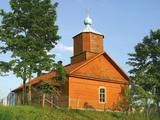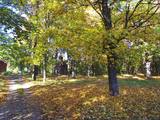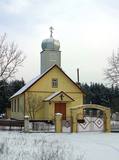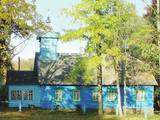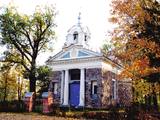| Nr | Name | Beschreibung |
|---|---|---|
|
Celta ~ 1560. g. vietā, kur agrāk atradusies Sakas osta. Dievnamā apskatāms > 170 gadus vecs kuģa modelis. Vietējie ticēja, kas tas aizsargā jūrniekus un bojāejas. Šāda tradīcija Latvijā ir novērojama tikai dažās baznīcās. Baznīcu var apskatīt arī no iekšpuses. |
||
|
Находится в стороне от площади Куршу, ул. Э.Венденбаума, д. 1. Старейшая церковь города, сведения о которой сохранились с 1508 года. Первый храм на этом месте был построен из дерева. После неоднократных перестроек (последняя – в 1893 г. под руководством архитектора Лиепаи Пауля Макса Берчи) храм приобрел теперешний вид в неоготическом стиле с башней высотой около 60 м. Церковный интерьер славится одним из самых выдающихся шедевров времен барокко в Латвии – алтарем (резчик по дереву Николя Сефренс младший), который в 2012 году отметил свое 350-летие.Алтарь считается одной из самых выдающихся работ Восточной Европы того времени. Ретабло алтаря (5,8 x 9,7 м) известно тематическим циклом страданий Иисуса. В храме находится третий по величине орган Латвии, который построен по эскизам композитора и органиста Альфреда Калниньша. Церковь можно осмотреть изнутри и подняться на колокольню. |
||
|
Das Gotteshaus ist von 1937 bis 1940 gebaut worden und als sein Prototyp hat die Auferstehungskirche in Kaunas in Litauen gedient. Die Kirche ist ein einschiffiges Gebäude, das in geometrisch rechteckigen Formen gebaut ist, die dem Stil Funktionalismus charakteristisch sind. In der Kirche befindet sich ein großer Altar aus Holz, eine Kanzel und zwei Seitenaltäre (am Anfang des 19. Jh. hergestellt), die früher die Kirche von Rokišķi geschmückt haben. Aus der Kirche von Rokišķi wurden die beiden Altäre hier gebracht, weil in der Kirche von Rokišķi eine neue Innenausstattung hergestellt wurde. Im Jahr 1997 hat die Kirche die Blaue Fahne des Europäischen Kulturerbes erhalten. Neben dem Gotteshaus befinden sich das in der zweiten Hälfte des 19. Jhs. aus roten Ziegeln gebaute Tor der katholischen Kirche und der Park der Selen. |
||
|
Atrodas ciema ziemeļdaļā. Neliela vienstāvu ēka ar svaigi nomainītu jumtu. Pēc vieniem avotiem celta 1883. gadā, citiem – pamatakmens ielikts 1933. g. 1. maijā. Tā tapusi pēc vietējo iedzīvotāju ziedojumiem uz Pirču māju zemes (saimnieks zemi atdevis dievnama celtniecībai). Baznīcas iekārta 2. pasaules kara laikā gāja bojā, tādēļ mūsdienās redzamā ir tapusi 20. gs. otrajā pusē. |
||
|
The Lode (Apši) Lutheran Church is between Lake Bānūži and Lake Ilze. It is a unique example of wooden architecture and dates back to 1780. The log church had a straw roof until the early 20th century, at which point a shingled roof was installed instead. |
||
|
Lipuški Old-Believers Prayer House was built in 1893 at lake
Rāzna in village Lipuški. In former days, it was one of the largest Old-
Believers parishes in the Baltic countries; you will notice Old-Believers cemeteries that are placed in the
neighbourhood.
|
||
|
Puša Manor - Chapel was built in the end of the 18th century; it is located
in the Pušas Manor park that was built in the middle of the 19th
century. Both are permanent local architectural monuments.
|
||
|
Malta (Borovaja, Borovska) Old-Believers Prayer House. The construction
of the church was started in 1931 by A. Gruncevičs. The Church is an architectural
monument of local importance.
|
||
|
Der höchste Punkt im Südteil von Daugavpils – in der Umgebung der 18. Novembra Straße, wo auf einem relativ kleinen Territorium, im Umkreise von ~ 0,3 km sich die Kirchen von vier Konfessionen befinden: das Bethaus für Altgläubige in Daugavpils (1908 – 1928), die St. Boris und Gleb russisch-orthodoxe Kathedrale (1905), die römisch-katholische Kirche der Heiligsten Gottesmutter (1905) und die evangelisch-lutherische Kirche Martin Luthers (1893). |
||
|
Eine 1651 gebaute Kirche wurde mit Pausen während des Halbjahrhunderts gebaut. Die ist voll umgebaut und heutige Ansicht erhielt 1876. In der Kirche befindet sich ein der bedeutendsten sakralen Einrichtungsgegenstände Lettlands – die älteste im Stil des Manierismus errichtete Kanzel Lettlands (1590) und die im 19. Jahrhundert eingestellte Kapellenglocke einer zerstörten Ritterburg (1450), die die älteste Kirchenglocke Lettlands ist. Das vom deutschen Meister F. Wolf geschaffene Altarbild “Christus am Kreuz” sowie der Altar sind vor kurzem renoviert worden. |
||
|
Die Kirche befindet sich an dem nordöstlichen Ufer des Sees Mazais Subates ezers. Das Gotteshaus ist von 1685 bis 1686 im byzantinischen Stil laut der Anweisung des Besitzers des Landgutes von Prode H. F. Osten-Sacken gebaut worden. Diese Kirche ist die einzige Kirche in Lettland, deren Architektur den Formen eines idealen protestantischen Gotteshauses aus dem Ende des 17. Jhs. ähneln, Interessant sind die kleinen Türme an den Gebäudeecken. Die Innenausstattung des Gotteshauses bilden reichlich ornamentierte und mit Skulpturen verzierte Holzschnitzereien, darunter auch der Altar aus dem 17. Jh., die Kanzel und die Beichtbank, sowie Kunstwerke aus dem 17. bis 18. Jh. und eine im Jahr 1682 gegossene Glocke. Es ist noch zu erwähnen, dass einen Teil der Innenausstattung der Kirche die Handwerker der Holzbildbauerschule aus Stelmuže hergestellt haben. |
||
|
Der Bau des Gotteshauses im neoromantischen Stil fand von 1936 – 1939 nach einem Entwurf des Architekten Pawlow statt, sie wurde bereits vor Beendigung der Bauarbeiten 1937 eingeweiht. Es ist der Gottesmutter der Schmerzen (Mater dolorosa) gewidmet, dieser Thematik ist auch der Hauptaltar geweiht. In dem Gebäude befinden sich Heiligenbilder aus dem Anfang des 20. Jh., im Garten beim Eingang steht eine Statue der Gottesmutter von Fatima. |
||
|
Gebaut als ein Gebäude des Festungstyps. Wurde in der Zeit des Livländischen Kriegs und des Nordkriegs zerstört. 1865 wurde der heutige Turm gebaut. Die von J. V. Rabe gebaute Kanzel mit Spindeltreppe. |
||
|
Das Gotteshaus hat eine nicht traditionelle Planung und Einrichtung: Der Altar befindet sich in der Mitte, aber die Kanzel – über dem Altar. Die Kirche hat einen eigenartigen Glockenturm mit einer im Jahr 1634 gegossenen Glocke. Die heutige Innenausstattung aus Holz haben die Schüler der Handwerkerschule von Riga geschaffen. Neben der Kirche befinden sich die Ruinen der alten Kirche und das Pfarrhaus, wo am Ende des 18. Jhs. als Hauslehrer Garlieb Merkel gearbeitet hat, der das in Liepupe Beobachtete in seinem bedeutenden Werk Letten verwendet hat. |
||
|
Štikāni Old-Believers Prayer House. The construction works of the church were held in 40s of the 20
th century on the site of the previous church built by brothers Rogozini. You should see Gospel (the protected
art object).
|
||
|
according to legend, was washed into the sea because of collapsing shores along with other buildings and the old road. The church was built in 1862 and has an altar painting from the late 19th century, "Mother of God," along with an organ. The metal elements of the building's doors are interesting. Hanging from the ceiling of the church is a sailing ship that has to do with the rescue of the crew of the sunken ship. |
||
|
Kulnevskaya (Ilzeskalns) Orthodox Church was built in 1832 by Kulnevs, the landlord of Ilzenberg
(Ilzeskalns) manor house. He was also the brother of Jacob Kulnevs. The Church has an iconostasis with
icons of the 19th century. The rectangular building has semicircular niches at its sides. The members of Kulnevs
family are buried here. The place of tomb is a rare phenomenon in Orthodox churches of Latvia.
|
||
|
Meklējama Nīcgalē, starp Rīgas – Daugavpils šoseju (A 6) un Daugavas krastu. Baznīcu cēla (neogotikas stils) pēc muižnieka Henriha Plātera - Zīberga iniciatīvas 1862. - 1863. g., veltot to Jaunavas Marijas dzimšanai. Kā jau daudzas citas baznīcas, arī šī ēka un tās interjera priekšmeti cieta 1. pasaules kara laika notikumos. To atjaunoja 1922. gadā. Baznīcas iekārta ir saglabājusies no 19. gs. 60. gadiem, bet, centrālā altāra augšdaļu pārbūvēja 1957. gadā. Dažus gadus vēlāk - 1961. g. uzstādīja ērģeles. |
||
|
Atrodas pilsētas centrā, Atbrīvošanas alejā 98. Dievnamu sāka celt 1840. g. (iesvētīja 1846. g.) un tas uzskatāms par pilsētas vecāko sakrālo būvi. Nekvalitatīvu būvniecības materiālu izmantošana un cēlāju pieredzes trūkums bija iemesls, kādēļ 1854. g. to nācās pārbūvēt. Pie baznīcas atrodas 1867. g. būvēta Sv. A. Ņevska kapliča, kas veltīta cara Aleksandra II paglābšanās faktam vilciena katastrofā un stikla mauzolejs, kurā apbedīts baznīcas mecenāts ģenerālis Karaulovs (šobrīd tiek restaurēts). Dievnams ir atvērts arī apmeklētājiem. |
||
|
Atrodas Jasmuižas austrumdaļā. Dievnams celts 1815. g., bet pārbūvēts 1932. g. |
||

